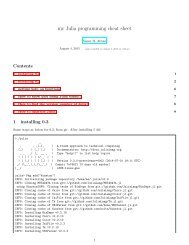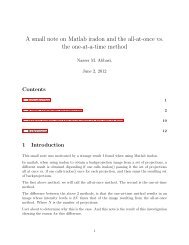You also want an ePaper? Increase the reach of your titles
YUMPU automatically turns print PDFs into web optimized ePapers that Google loves.
8.3.2 Under-damped forced vibration c < c r , ξ < 1<br />
u<br />
K<br />
C<br />
M<br />
Fsin t<br />
mu ′′ + cu ′ + ku = F sin ϖt<br />
u ′′ + 2ξωu ′ + ω 2 u = F sin ϖt<br />
m<br />
The solution is<br />
where<br />
and<br />
u (t) = u h + u p<br />
u h (t) = e −ξωt (A cos ω d t + B sin ω d t)<br />
u p (t) =<br />
F<br />
√(k − mϖ) 2 + (cϖ) 2 sin (ϖt − θ)<br />
where<br />
tan θ =<br />
cϖ<br />
k − mϖ 2 =<br />
2ξr<br />
1 − r 2<br />
Very important note here in the calculations of tan θ above, one should be careful on the sign of the<br />
denominator. When the forcing frequency ϖ > ω the denominator will become negative (the case of ϖ = ω is<br />
resonance and is handled separately). Therefore, one should use arctan that takes care of which quadrant the<br />
angle is. For example, in Mathematica use<br />
ArcTan[1 - r^2, 2 Zeta r]]<br />
and in Matlab use<br />
atan2(2 Zeta r,1 - r^2)<br />
Otherwise, wrong solution will result when ϖ > ω The full solution is<br />
u (t) = e −ξωt (A cos ω d t + B sin ω d t) + F k<br />
1<br />
√(1 − r 2 ) 2 + (2ξr) 2 sin (ϖt − θ) (1)<br />
Applying initial conditions gives<br />
A = u (0) + F k<br />
B = u′ (0)<br />
ω d<br />
+<br />
1<br />
√(1 − r 2 ) 2 + (2ξr) 2 sin θ<br />
u (0) ξω<br />
ω d<br />
+ F k<br />
Another form of these equations is given as follows<br />
1<br />
ω d<br />
√<br />
(1 − r 2 ) 2 + (2ξr) 2 (ξω sin θ − ϖ cos θ)<br />
38





